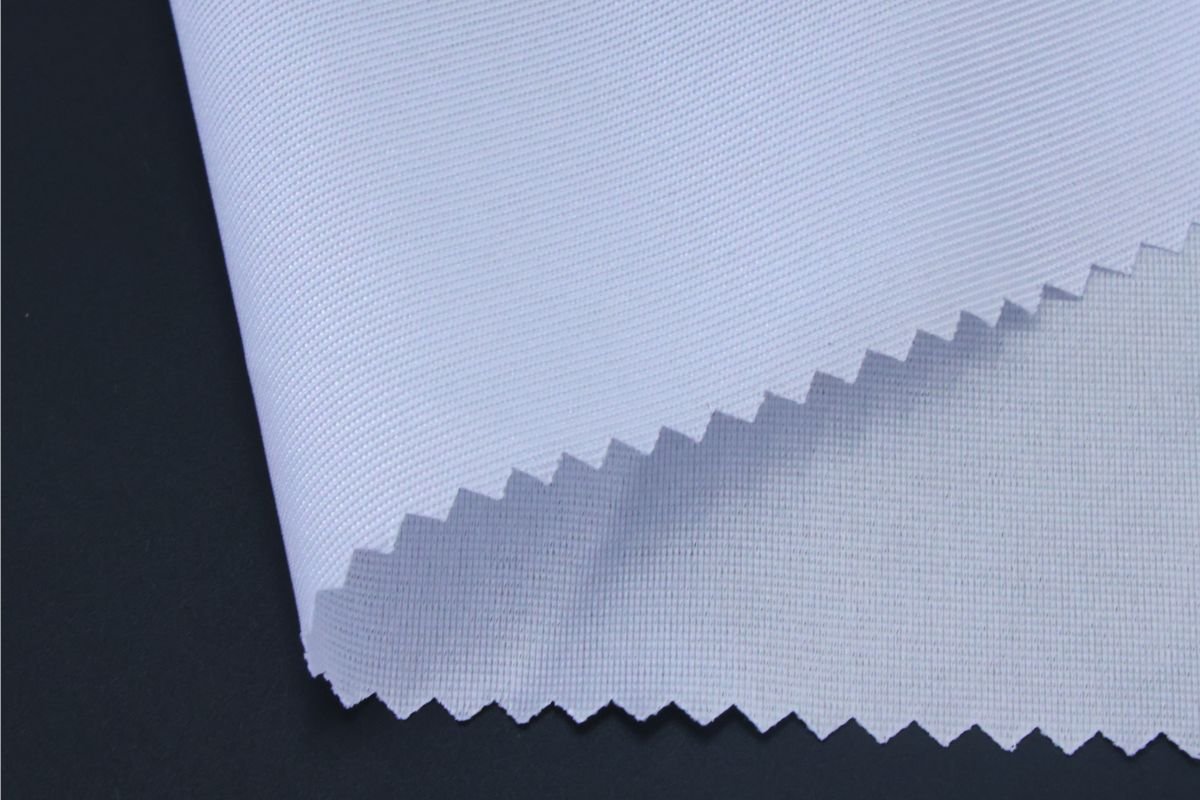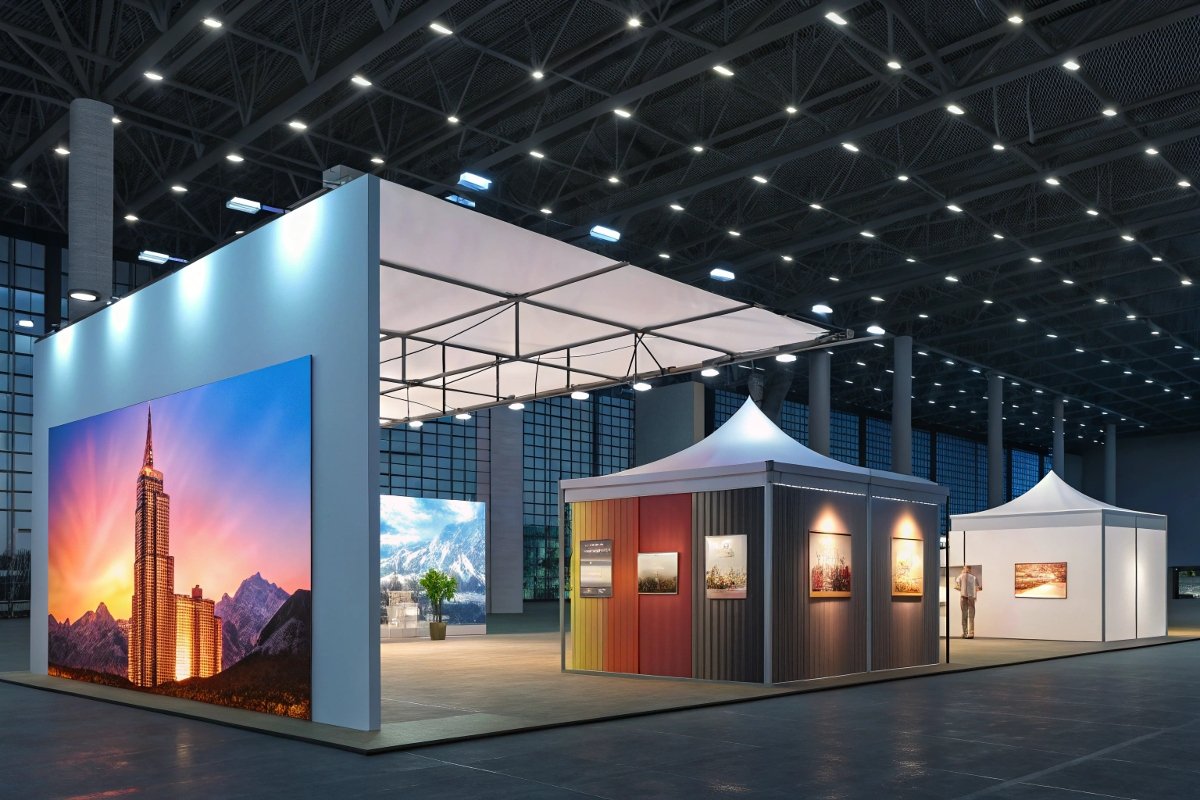Have you ever walked past a huge, glowing display at a shopping mall or an airport and been captivated by how vibrant and evenly lit the image is? Chances are, you were looking at something printed on "backlit fabric." It's a special material that truly makes graphics pop, especially in dimly lit environments or at night.
Backlit fabric is a high-performance textile material, typically made from polyester[^1], engineered to evenly diffuse light when illuminated from behind. Its unique translucent properties and often stretchable nature allow for brilliant, uniformly lit graphics that are commonly used in lightboxes, display systems, and various architectural applications.

Through my journey from working in a signage media factory to running my own manufacturing operation, I've seen how crucial innovation is. Backlit fabric has been a game-changer. I remember clients always seeking new ways to make their advertisements more impactful, especially indoors or during evening hours. When we started producing high-quality backlit fabrics, it opened up a whole new realm of possibilities for them. It's a key product we now provide, and it helps our partners, like Mr. Watford, find cutting-edge solutions for their advertising needs. This material consistently delivers the vibrant color reproduction and consistent quality our customers demand.
What are the Specifications for Backlit Fabric?
Understanding the technical details helps us grasp why backlit fabric performs so well. These specifics directly impact its appearance, durability, and how easily it can be used.
Backlit fabric specifications primarily involve its composition (usually polyester), knitting type (woven[^2] or warp-knitted[^3]), maximum width (which can reach up to 5 meters), and crucial flame retardancy[^4] ratings like B1 according to European standards. It is often designed with slight stretch capabilities in two directions to facilitate taut installation within display frames.

When a client approaches me looking for backlit material, these specifications are the first things we discuss. Most backlit fabrics are made of polyester because of its excellent print receptivity and durability. We commonly encounter two main types of polyester fabric construction: woven and warp-knitted. Both have their advantages, but warp-knitted often provides a bit more stretch, which is very useful during installation.
The ability to achieve widths of up to 5 meters is a huge advantage for large format graphics, making seamless backdrops possible. Fire safety is also extremely important, especially for indoor public spaces. This is why we always ensure our backlit fabrics meet strict fire ratings, like the European B1 standard, which signifies low flammability. This attention to detail ensures not only a beautiful display but also a safe one.
Key Specifications of Backlit Fabric
| Specification | Description | Significance |
|---|---|---|
| Composition | Primarily Polyester Fabric (PES)[^5]. | Excellent print receptivity, durability, and light diffusion. |
| Fabric Construction | Available in Woven or Warp-Knitted types. | Affects stretch, stability, and overall drape. |
| Stretch/Tension | Often designed with two-way stretch for taut installation. | Facilitates smooth, wrinkle-free fitting into frames. |
| Maximum Width | Can extend up to 5 meters. | Allows for seamless, large-scale graphic displays. |
| Flame Retardancy | Typically meets B1 European Standard[^6]. | Crucial for safety in public and indoor environments. |
| Translucency/Diffusion | Engineered for even light dispersion. | Ensures uniform and vibrant illumination from behind. |
Where is Backlit Fabric Used?
The versatility and visual appeal of backlit fabric make it suitable for a wide array of captivating applications beyond traditional signage.
Backlit fabric is extensively used to create striking illuminated displays in various indoor and outdoor environments, including retail settings (backlit fabric displays, lightboxes), architectural features (backlit fabric ceilings, walls), event branding (backlit fabric trade show booths, banner stands), and specialized structures like backlit awnings and tents.

I've worked with architects and event organizers who are constantly pushing the boundaries of visual communication. Backlit fabric has become a go-to material for them. For instance, I've seen it transform a plain wall into a dynamic feature with a "backlit fabric wall," or make a retail space feel more open and modern with a "backlit fabric ceiling."
Think about how a simple "backlit fabric lightbox" instantly elevates a product display in a shop window. At trade shows, a "backlit fabric trade show booth" offers an unmissable glow amongst competitors, drawing attendees in. Even for events, "backlit awning fabric" or a "backlit fabric tent" provides not just shelter, but also powerful branding that catches the eye day and night. From compact "backlit fabric banner stands" to expansive interior design elements, this material truly brings graphics to life.
Common Uses of Backlit Fabric
| Application | Description |
|---|---|
| Backlit Fabric Displays | General illuminated graphics for retail, events, and advertising. |
| Backlit Fabric Lightboxes | Framed, internally lit displays common in malls, airports, and stores. |
| Backlit Fabric Ceilings | Architectural elements creating ambient and branded overhead lighting. |
| Backlit Fabric Walls | Large-scale illuminated wall graphics for branding or ambiance. |
| Backlit Awning Fabric | Awnings and canopies that can be illuminated for nighttime visibility. |
| Backlit Fabric Tents | Illuminated structures for outdoor events, offering both shelter and branding. |
| Backlit Fabric Trade Show Booths | Eye-catching, glowing booth elements for exhibition environments. |
| Backlit Fabric Banner Stands | Portable, illuminated stand-alone displays for easy setup at events. |
What Method is Used to Print Backlit Fabric?
Choosing the right printing method is essential to achieve the vibrant, evenly lit results that backlit fabric is known for. Not all inks or processes work equally well.
To achieve optimal light diffusion and color vibrancy on backlit fabric, the primary printing methods used are dye-sublimation, UV-curable, and HP Latex. Dye-sublimation excels for rich, soft graphics, while UV-curable offers durability for outdoor use, and HP Latex provides a versatile, environmentally friendlier middle ground.

In my experience, each print method has its strengths. My team works with clients to determine the best approach based on their specific needs. For instance, "backlit fabric dye sublimation" is fantastic for applications where you need incredibly vivid, deep colors and a soft hand feel. The dyes actually become part of the fabric, so the print won't crack or peel. This is often preferred for high-end retail displays.
"UV curable" printing involves inks that are cured instantly with UV light. This method provides a durable, scuff-resistant print that is great for outdoor backlit signs, as the inks are very robust against weather and fading. Finally, "HP Latex" printing offers a versatile solution. It uses water-based inks, making it more environmentally friendly, and it produces excellent print quality with good durability for both indoor and outdoor backlit applications. The choice often comes down to the desired color vibrancy, environmental considerations, and the expected lifespan and exposure of the final product.
Printing Methods for Backlit Fabric
| Printing Method | Description | Key Advantages | Ideal For |
|---|---|---|---|
| Backlit Fabric Dye Sublimation | Dyes are heat-transferred into the fabric, becoming part of the fibers. | Extremely vibrant colors, high resolution, soft feel, durable. | Indoor lightboxes, high-end displays, art installations. |
| UV Curable Printing | UV inks are printed onto the surface and cured instantly with UV light. | High durability, scratch and abrasion resistance, good for outdoors. | Outdoor lightboxes, long-term exterior backlit signs. |
| HP Latex Printing | Water-based latex inks are printed and cured with heat. | Environmentally friendly, good print quality, versatile indoor/outdoor. | Diverse applications needing eco-friendly and good durability. |
How is Backlit Fabric Installed?
Proper installation is critical for ensuring backlit fabric displays look professional, wrinkle-free, and perform as intended. Poor installation can ruin even the best print.
Backlit fabric is primarily installed using tensioning frame systems designed to pull the fabric taut and flat. Common methods include silicone edge graphics (SEG), frame systems with Keder beading, or stretch frame systems that allow the fabric to stretch slightly and fit snugly, ensuring a smooth, wrinkle-free illuminated surface.

As someone who helps partners set up their production facilities, teaching proper installation is just as important as supplying great material. The goal is always a perfectly smooth, evenly lit surface. The most common and effective method I've seen is the Silicone Edge Graphic (SEG) system. With SEG, a thin silicone strip is sewn around the edges of the printed fabric. This strip then slots into a specialized groove in an aluminum frame, pulling the fabric drum-tight. This creates a very clean, frameless look when illuminated.
For large-scale applications, we also use frame systems that employ a Keder[^7] beading or similar profiles to secure the fabric. The slight stretch inherent in many backlit fabrics, whether woven or warp-knitted, is a huge advantage here. It allows installers to exert even tension, eliminating sagging or wrinkles, which are the worst enemies of a crisp backlit graphic. This process ensures that the final display is not only visually stunning but also easy to maintain and update.
Common Installation Methods for Backlit Fabric
| Installation Method | Description | Advantages |
|---|---|---|
| Silicone Edge Graphics (SEG) | A silicone strip sewn onto the fabric edge fits into a frame groove. | Provides a seamless, frameless look; easy graphic changes. |
| Keder / Slot System | A rope-like Keder bead sewn to the fabric edge slides into a channel. | Secure and taut fit for large format textiles, good for modular systems. |
| Stretch Frame Systems | Frames designed with an internal mechanism to pull the fabric using its inherent stretch. | Ensures extreme flatness and wrinkle-free appearance; often tool-less installation. |
| Velcro / Hook & Loop | Fabric edges are finished with Velcro which adheres to a frame. | Simple, relatively quick for smaller or temporary displays. |
| Grommets & Bungee Cords | Metal eyelets[^8] (grommets) on the fabric, tensioned with bungee cords. | Economical and effective for outdoor banners on scaffolding or fences. |
Conclusion
Backlit fabric is a versatile, light-diffusing polyester textile used in illuminated displays like lightboxes and architectural features, available in various specifications and printed with methods like dye-sublimation, UV-curable, or HP Latex. It is installed using tensioning systems such as SEG to create vibrant, smooth, and impactful visuals.
Annotated Reading:
- Polyester: A synthetic polymer widely used in textiles. It is known for its durability, resistance to stretching and shrinking, and quick-drying properties, making it ideal for various fabric applications including banners. https://en.wikipedia.org/wiki/Polyester
- Woven: A method of textile production where two distinct sets of yarns or threads are interlaced at right angles to form a fabric or cloth. This creates a strong and stable material.
- Warp-Knitted: A type of knitting technique where loops are formed vertically along the length of the fabric. This method produces knit fabrics that are generally more stable, less likely to unravel, and may offer more stretch than woven fabrics. https://en.wikipedia.org/wiki/Warp_knitting
- Flame Retardancy: The property of a material to self-extinguish or resist ignition and spread of fire, often achieved through chemical treatments or inherent material properties. Essential for safety compliance in public spaces.
- PES (Polyethylene Terephthalate): Another common name or acronym for Polyester, particularly in its form as a textile fiber.
- B1 European Standard: A widely recognized European classification for the flame retardancy of building materials, indicating low flammability. Materials meeting B1 have limited contribution to fire and are often required for public indoor spaces.
- Keder: A flexible, rope-like PVC or fabric strip that is welded into a groove along the edge of a fabric panel, allowing the fabric to be easily and securely slid into an aluminum frame channel.
- Grommets: Metal rings or eyelets typically inserted into banners or fabrics to reinforce holes, allowing the material to be hung or secured without tearing.


